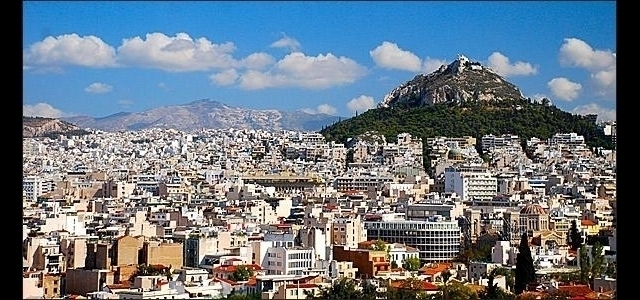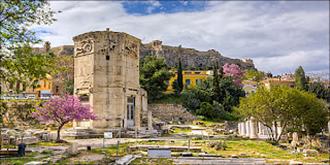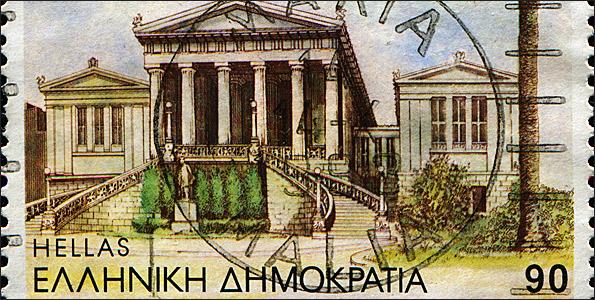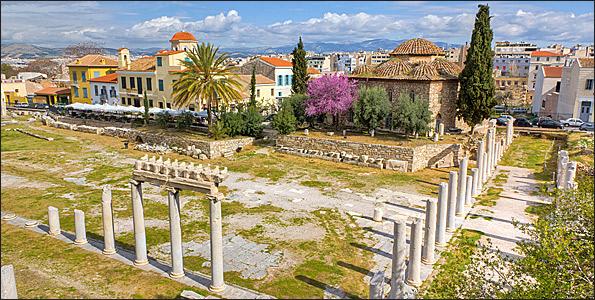From GRReporter

Picture: http://www.pinnokio.gr
Behind which church does the neighbourhood called
Anafiotika (i.e. neighbourhood of immigrants from the island of Anafi)
begin? Which is the Fethiye Mosque? Is there a way to get from Syntagma
Square to Panathinaikos Stadium without crossing a single avenue?The best way to feel that you do not know the city is to walk around it with a tourist guide in your hands. To encounter the remarkable building, which is marked with a red 9 on the map entitled "walking tour", just to make sure that you drive past it every day, but have never seen it. And then to follow the directions to that nice cafeteria, which you have not discovered yet, and to try the wonderful cuisine of the little tavern, which you have avoided for so long because you have considered it a tourist one.
 When
turning the pages of a guide to Athens, there are two things you find:
firstly, there are and there will always be things, which you ignore,
even if you have been living there for a whole lifetime. And secondly,
contrary to what they want to believe at the Ministry of Tourism,
visitors to Athens are not only interested in the Acropolis and the
ancient history. As described by the guidebook, they can see the
nightlife, the restaurants area from Thiseio to Makriyianni, and enjoy
the walks in the centre of a city which is "downright fun".
When
turning the pages of a guide to Athens, there are two things you find:
firstly, there are and there will always be things, which you ignore,
even if you have been living there for a whole lifetime. And secondly,
contrary to what they want to believe at the Ministry of Tourism,
visitors to Athens are not only interested in the Acropolis and the
ancient history. As described by the guidebook, they can see the
nightlife, the restaurants area from Thiseio to Makriyianni, and enjoy
the walks in the centre of a city which is "downright fun".In connection with the World Tourism Day, with the last Lonely Planet guidebook from March this year in hand, we followed the step-by-step route for a weekend. And we learned a lot.
Syntagma-Panathinaikos through the gardens
The route starts at the Peisistratous Aqueduct. If you do not know where it is, then you have never even thrown a glance to the left at the exit of the subway at Syntagma square. It crosses the National Garden and Zappeio where the Olympic Village during the first Olympic Games was, and ends in the playground of Zappeio at the exit of Panathinaikos Stadium. And all this without even crossing a single boulevard.
Lysikratous Monument versus Diogenes Lantern
In Plaka we are stopping at the monument of Lysikratous which most Athenians call Diogenes Lantern (the Byzantine name) and which is the respective "Oscar of the Ancient World", i.e. the award given to the sponsor of the best performance at the Theatre of Dionysus. The first known monument in the world with Corinthian capitals was included at a certain point in a French Capuchin monastery where Lord Byron wrote his famous work "Childe Harold" in 1810-11. The monastery was destroyed by fire in 1890.
Anafiotika
From Diogenes Lantern the trip follows the narrow streets of Stratonos and Epimenidou, to stop at the small church of "St. George on the rocks", where the entrance to Anafiotika is. The small pleasant neighbourhood with whitewashed houses, blue windows and patios with flowers, takes its name from the settlers - craftsmen from the island of Anafi, who came from the tiny island in the Aegean Sea to Athens in order to build the king's castle after the independence.

Universities, old and new
Following the hand-painted signs showing the Acropolis, from Anafiotika we arrive at the small church of "St. Simeon." This is not a dead-end street, if you go ahead you will reach the old university housed in an impressive building, built in ochre by the Venetians. During the Ottoman rule there were offices here, and from 1837 to 1841 it was the first university of free Athens, until Danish architect Christian Hansen designed the magnificent neoclassical building of the University, completed in 1864. Speaking of Panepistimiou Street (University Street), the building of the Academy, which complements the famous neoclassical trilogy (together with the University and the National Library) was designed by Hansen's brother, Theophilous, and was completed in 1885. The Ionic columns at the entrance are an exact replica of the eastern entrance of the Erechtheum.
What was the Numismatic Museum, before it became a museum?
Staying for a while on Panepistimiou, we sit at a coffee table in the lovely garden of the Numismatic Museum, which is also housed in a fantastic neoclassical building, Iliou Melathron. Before housing the 400,000 coins collection from ancient Greece and Byzantium, it was home to archaeologist Heinrich Schliemann.
Two centuries old Athens
Have you ever wondered what Athens was like before 1842? Or earlier, before the crash in Venice in 1687? The answer lies in a remarkable model and a giant picture. Both can be seen at the Museum of Athens, which is located in the palace where King Otto lived until 1846.

And a bit from the Ottoman Empire
The place around Aerides (The Tower of Winds) in the Plaka/Monastiraki area, is full of objects from the Ottoman Empire, which are growing older in not a very pleasant way behind gates with heavy padlocks, since the Ministry of Culture is trying to forget them and perhaps hoping that they will collapse on their own. A typical example is the Fethiye Mosque in the Roman Agora. A rare exception to the rule are the Turkish baths from the 17th century, up to the Tower of the Winds, which can be visited.
Hadrian and his Athens
In front of the largest temple of antiquity, that of Olympian Zeus (with 104 Corinthian columns, a height of 17 metres and more than 700 years to complete the temple) Emperor Hadrian erected a majestic arch, a year after the church was completed, on one side of which is written, "This is Athens, the ancient city of Theseus" and on the other - "This is Athens, the city of Hadrian and not of Theseus", to mark the boundary between the ancient and the Roman city. The arch was built in 132 AD.
The first bell which tolls in Athens
"St. Nicholas Rangavas" may not be the oldest church in Athens (this title is held by the little church "Holy Apostles" in the ancient agora), although it is from the 11th century. It was, however, the first one to obtain a bell, something which was forbidden during the Turkish rule. This bell announced the liberation of Athens in 1833. The church on the corner of Pritaniou and Epiharmou streets in Plaka is part of the Rangavas' family palace which originates from the Byzantine Emperor Michael the First.
http://gogreece.about.com/gi/o.htm?zi=1/XJ&zTi=1&sdn=gogreece&cdn=travel&tm=8&f=22&su=p531.60.342.ip_&tt=2&bt=1&bts=1&st=13&zu=http%3A//www.grreporter.info/en/

No comments:
Post a Comment